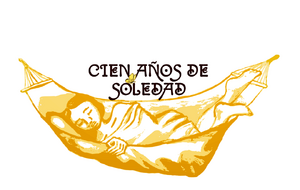Cien Años de Soledad larp

Cien Años de Soledad larp is a Czech experimental larp introduced in 2016 and played multiple times since then.
Summary
Cien Años de Soledad larp is inspired by the book One Hundred Years of Solitude by Gabriel Garcia Márquez. The game is trying to explore specific experience and culture of the South American people in drastic changes during one hundered of years it describes. It connects mythical stories with everyday life through intimate stories of one family. To achieve the feeling of the book and magical realism as a genre it uses several game design techniques.
Statistics
The production had 31 players in one game of cca 30 hours. Before the game, there are few hours of workshops to learn to use specific game techniques and play style fitting with the mood of the game. There were 6 runs in Czech Republic - two in 2016, two in 2017 and two in 2019. Participation fee in Czech Republic was cca 80 EUR per run, food and accommodation (camp style) included.
Techniques
- Pre-larp Workshop - workshops game techniques and play style for cca 6 hours.
- Flying Start - at a specific signal.
- Sudden end- specific event ending the story.
- NPC - many, mostly short time appearance.
- Soundtrack - specific sound to create the feeling of time progression.
- Tap Out - non-verbal and Safewords.
- Alter-egos - three players play one character. The game is basically about one family, but that family is there three times - three players play same character in the same story. They can play with each other as an internal monologue or as best friends. Towards others they can play all at once, or as different characters. It is stron part of creating the magical realism of the story and the feeling of repetitivness.
- Reincarnation - each player playes more than one character. The game takes one hundred years, characters die and are born in the game. In the meantime, they can also play ghosts. It is part of creating magical realism and the feeling of repetitiveness.
- Fateplay - each character had scripted story. In this game characters story is set by designers and players know it, they are trying to fulfill that story and give it meaning.
- Taste of Intimacy - sex was symbolised by feeding each other a lolypop.
- Colours of Relationships - relationships of characters were communicated to players through colors of clothes. Players know, the character will have feelings towards a person wearing some kind of color and organizers give people clothes in the game.
- Game Master - giving new inputs in the game. Game designers are free to move in the game as helpers or servants of the characters, their influence is usually managed within a game story.
- Fluid Time - in line with magical realistic genre, time of the game is a divided in parts but they are not binding and too specific.
- Cut Scene - Flashbacks and reinterpretation of the past scenes as much as players want and any time in the game delivering feeling of very fluid time, repetitivness and magical realism.
Game design choices
- Openness - game is cca 80% transparent.
- Scenography - closer to 360°, but not focused on detail.
- Character Creation Responsibility - characters storyline mostly created by organisers with only limited input from players. But it us up to players to interpret the motives of characters actions, which are not clearly stated.
- Runtime Game Mastering - Quite strong influence of Game Masters in the game.
- Story Engine - Collaborative, focused on emotional drama.
- Loyalty to Setting - Playable, strongly inspired by magical realism.
- Bleed-in - Quite differentiated.
- Communication Style - Combined physical and werbal playing.
- Representation of Theme - Abstract related to genre.
- Meta-techniques - Many, see above.
- Player Pressure - Pretense, but mentally demanding, considering quite complex game design.
Articles
- One Hundred Years of Solitude - mapping of a temporary network
- The binding of Jose Arcadio to the fence_ a cognitive ethnography of situational normativity of moral controversy in the LARP game Cien Años
Authors
- Sarah Komásová
- Lukáš Brychta
- Tomáš Hampejs
- Kateřina Morgain Holendová
